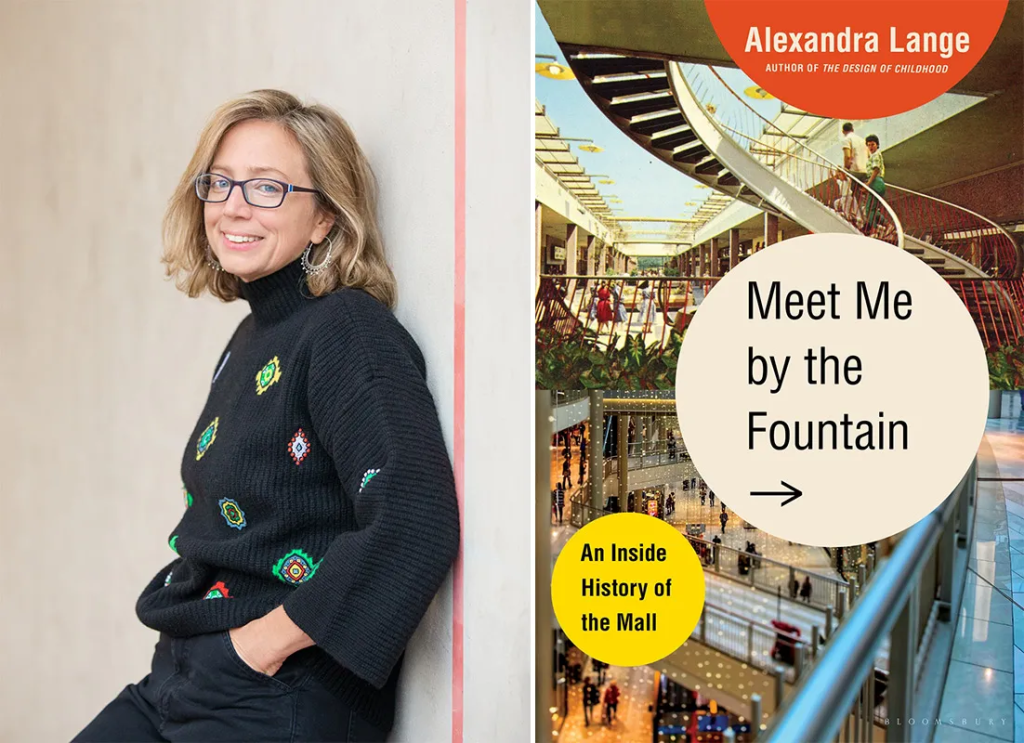American malls are so ubiquitous that it is difficult to consider they were purposefully conceived, actively designed, and meticulously managed. Every facet of an atrium ceiling or food court placement was decided based on cost, profitability, and aesthetics. But malls have rarely been considered as Serious Architecture.
Meet Me by the Fountain, An Inside History of the Mall by Alexandra Lange fills in that gap. Lange will be joining The Urbanist Book Club on January 17th at 6pm to discuss her work and what she sees as the appeal of malls. Sign up to join the discussion here.
Alexandra Lange is a design critic with published works in Harvard Design Magazine, The Atlantic, and the New York Times. She is a columnist for Bloomberg CityLab, and has been a featured writer at Design Observer, an opinion columnist at Dezeen, and the architecture critic for Curbed. Her previous book, The Design of Childhood: How the Material World Shapes Independent Kids explored the history of children’s playthings, and its affect on their journey to independence. The book is assigned text in art and architecture studios at ASU to MIT to VCU.
It’s not that far of a pivot, then, to consider malls as the playthings for the White Middle Class. From architect Victor Gruen’s original concepts to decant a downtown department store to the suburbs through James Rouse’s utopian garden city of Columbia, Maryland built around the modern central plaza, there are deep ties between shopping and the type of people who folks were comfortable shopping next to. Malls have always been designed to adapt to those expectations.

Lange covers the design choices that were made to reinforce the image that developers and owners wanted their mall to portray. Scrutinized font choices and logos are just the beginning for establishing consistent branding for a new shopping destination. Designers used their entire toolkit to make a mall fit into a community, yet stand out as something special. Opening day for a new mall was a choreographed civic event. That makes the protests and demonstrations focusing on the malls in the 1970’s and 80’s so pivotal in the nation’s concept of public space and free speech. Almost as pivotal as the mall’s image in films like Fast Times at Ridgemont High and Clueless.
If only malls were as timeless as Paul Rudd. Today, most people think about malls as a chore. It’s the only place, not really that close any more, that has all of the shops needed to minimize a shopping excursion into one trip. And lunch. That is, unless there is an announcement that the mall is closing. Then the memories come out and the outpouring of reminiscing begins. It gives the image that the only truly modern mall is a dead mall.
But Lange has seen the future, and it lies back in those original design concepts. The mall is “an architecture born to be malleable, and in that malleability lies its future.” Wait till you read what that looks like.
You can listen to Ray’s conversation with Alexandra Lange on The Urbanist Podcast, available here or through your favorite podcast streaming service.
Register for Zoom link and suggest a question via this Google Form. We look forward to seeing you on January 17.
Ray Dubicki is a stay-at-home dad and parent-on-call for taking care of general school and neighborhood tasks around Ballard. This lets him see how urbanism works (or doesn’t) during the hours most people are locked in their office. He is an attorney and urbanist by training, with soup-to-nuts planning experience from code enforcement to university development to writing zoning ordinances. He enjoys using PowerPoint, but only because it’s no longer a weekly obligation.


